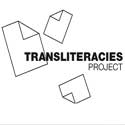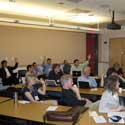SC 2.a – Syllabus
The following is an example syllabus for the second-year core course in a social computing IGERT. The references suggest example readings.
Week 1 & 2: Introduction
Social computing is the study of large-scale socially aware information systems. Current technologies span social networking sites (e.g., Facebook), media sharing sites (e.g., YouTube, Flickr), collaborative knowledge production (e.g., Wikipedia) and mapping sites (e.g., mashups). Developing a disciplined understanding of social computing, however, is an inherently interdisciplinary task requiring research and training across a spectrum of fields – including engineering, sociology, education, the humanities, communication, design, the arts, and media studies (Liu et al., 2008). Have these technologies changed our social attitudes and behaviors? How has social computing altered problems of collective action and information credibility? What research methods are effective in studying these phenomena? We start by defining social computing (Wang et al., 2007) and discussing Web 2.0 visions (O’Reilly, 2005; Rheingold, 2000; Brown and Duguid, 2002). We discuss how open-source software and collaborative knowledge production might be described as a new mode of economic production – described as non-market social production by Benkler (2006) or more generally as digital commons (Greco and Floridi, 2004). What are the theoretical ideas behind technology diffusion into society? We discuss utopian and dystopian visions, and technological determinism and social shaping of technology (Bimber, 1994; Mackay and Gillespie, 1992; Kling, 1996).
Week 3 & 4: Technology
We start by discussing the nature of theWeb and its behavioral and structural complexities (Adamic and Huberman, 2001; Albert et al., 1999; Fielding and Taylor, 2002). We review several key technologies and discuss their architecture and design:
- Blogging (Kumar et al., 2004);
- Collaborative filtering (Kautz et al., 1997) and tagging (Sen et al., 2006; Golder and Huberman, 2006; Halpin et al., 2007);
- Internet search (Barroso et al., 2003);
- Social media and networking sites (Boyd and Ellison, 2007); and
- Wikipedia and wikis (Priedhorsky et al., 2007; Almeida et al., 2007).
Week 5 & 6: Behavior
- Free-riding problems (Adar and Huberman, 2000; Beenen et al., 2004).
- Motivations and social psychology (Nardi et al., 2004).
- Online credibility (Metzger et al., 2003; Metzger, 2007; Rieh and Danielson, 2007).
- Social impacts (Katz and Rice, 2002; Kavanaugh et al., 2005).
- Social roles in online environments (Golder and Donath, 2004; Suler, 2004).
Week 7 & 8: Culture
- Authoring (Pfeil et al., 2006; Emigh and Herring, 2005).
- Globalization (Axford, 2004).
- Historical perspectives.
- Social presence (Schroeder, 2002).
- Virtual communities (Bakardjieva, 2003).
Week 9 & 10: Policy
- Intellectual property (Mitchell, 2005).
- Privacy (Gross et al., 2005).
References
- Adamic, L. A. and B. A. Huberman (2001). The web’s hidden order. Communications of the ACM 44(9), 55–60.
- Adar, E. and B. A. Huberman (2000). Free riding on gnutella. First Monday 5(10)
- Albert, R., H. Jeong, and A.-L. Barab´asi (1999). Internet: Diameter of the world-wide web. Nature 401(6749), 130–131.
- Almeida, R., B. Mozafari, and J. Cho (2007). On the evolution of Wikipedia. In 1st International Conference on Weblogs and Social Media, Boulder, CO.
- Axford, B. (2004). Global civil society or ‘networked globality’: beyond the territorialist and societalist paradigm. Globalizations 1(2), 249–264.
- Bakardjieva, M. (2003). Virtual Togetherness: An Everyday-life Perspective. Media, Culture & Society 25(3), 291.
- Barroso, L. A., J. Dean, and U. Holzle (2003). Web search for a planet: The Google cluster architecture. IEEE Micro 23(2), 22–28.
- Beenen, G., K. Ling, X. Wang, K. Chang, D. Frankowski, P. Resnick, and R. E. Kraut (2004). Using social psychology to motivate contributions to online communities. In ACM Conference on Computer Supported Cooperative Work, Chicago, Illinois, USA.
- Benkler, Y. (2006). The wealth of networks: How social production transforms markets and freedom. New Haven, CT: Yale University Press.
- Bimber, B. A. (1994). The three faces of technological determinism. In M. R. Smith and L. Marx (Eds.), Does technology drive history? The dilemma of technological determinism. Cambridge, MA: MIT Press.
- Boyd, D. M. and N. Ellison (2007). Social Network Sites: Definition, History, and Scholarship. Journal of Computer-Mediated Communication 13(1).
- Brown, J. S. and P. Duguid (2002). The Social Life of Information. Cambridge, MA: Harvard Business School Press.
- Emigh, W. and S. C. Herring (2005). Collaborative authoring on the web: A genre analysis of online encyclopedias. In 38th Annual Hawaii International Conference on System Sciences (HICSS ’05), Waikoloa, Hawaii.
- Fielding, R. T. and R. N. Taylor (2002). Principled design of the modern Web architecture. ACM Transactions on Internet Technology 2(2), 115–150.
- Golder, S. and J. Donath (2004, 19-22 September). Social roles in electronic communities. In Association of Internet Researchers Conference: Internet Research 5.0, Brighton, England.
- Golder, S. A. and B. A. Huberman (2006). Usage patterns of collaborative tagging systems. Journal of Information Science 32(2), 198–208.
- Greco, G. M. and L. Floridi (2004). The tragedy of the digital commons. Ethics and Information Technology 6(2), 73–81. doi:10.1007/s10676-004-2895-2.
- Gross, R., A. Acquisti, and H. J. Heinz, III (2005). Information revelation and privacy in online social networks. In ACM Workshop on Privacy in the Electronic Society, Alexandria, VA, pp. 71–80.
- Halpin, H., V. Robu, and H. Shepherd (2007). The complex dynamics of collaborative tagging. In 16th International Conference on World Wide Web, Banff, Alberta, Canada.
- Katz, J. E. and R. E. Rice (2002). Social consequences of Internet use: Access, involvement, and interaction. Cambridge, MA: The MIT Press.
- Kautz, H., B. Selman, and M. Shah (1997). Referral Web: Combining social networks and collaborative filtering. Communications of the ACM 40(3), 63–65.
- Kavanaugh, A. L., D. D. Reese, J. M. Carroll, and M. B. Rosson (2005). Weak ties in networked communities. The Information Society 21(2), 119–131.
- Kling, R. (1996). Hopes and horrors: Technological utopianism and anti-utopianism in narratives of computerization. In R. Kling (Ed.), Computerization and controversy: Value conflicts and social choices (2nd ed.)., pp. 40–58. San Francisco: Morgan Kaufmann.
- Kumar, R., J. Novak, P. Raghavan, and A. Tomkins (2004). Structure and evolution of blogspace. Communications of the ACM 47(12), 35–39.
- Liu, A. et al. (2008). Social computing group. UCSB.
- Mackay, H. and G. Gillespie (1992). Extending the social shaping of technology approach: Ideology and appropriation. Social Studies of Science 22(4), 685–716.
- Metzger, M. J. (2007). Making sense of credibility on the web: Models for evaluating online information and recommendations for future research. Journal of the American Society for Information Science and Technology 58(13), 2078–2091. doi:10.1002/asi.20672.
- Metzger, M. J., A. J. Flanagin, K. Eyal, D. R. Lemus, and R. M. McCann (2003). Credibility for the 21st century: Integrating perspectives on source, message, and media credibility in the contemporary media environment. Communication Yearbook 27(1), 293–335.
- Mitchell, H. C. (2005). The intellectual commons: Toward an ecology of intellectual property. Lanham, MD: Lexington Books.
- Nardi, B. A., D. J. Schiano, M. Gumbrecht, and L. Swartz (2004). Why we blog. Communications of the ACM 47(12), 41–46.
- O’Reilly, T. (2005, 30 September). What is web 2.0: Design patterns and business models for the next generation of software. Online article.
- Pfeil, U., P. Zaphiris, and C. S. Ang (2006). Cultural differences in collaborative authoring of Wikipedia. Journal of Computer-Mediated Communication 12(1).
- Priedhorsky, R., J. Chen, S. T. K. Lam, K. Panciera, L. Terveen, and J. Riedl (2007). Creating, destroying, and restoring value in Wikipedia. In 6th International Conference on Supporting Group Work (GROUP’07), Sanibel Island, FL. ACM.
- Rheingold, H. (2000). The virtual community: Homesteading on the electronic frontier (2nd ed.). Cambridge, MA: The MIT Press.
- Rieh, S. Y. and D. Danielson (2007). Credibility: A multidisciplinary framework. Annual Review of Information Science and Technology 41, 307–364.
- Schroeder, R. (2002). The Social Life of Avatars: Presence and Interaction in Shared Virtual Environments. New York: Springer.
- Sen, S., S. K. Lam, A. M. Rashid, D. Cosley, D. Frankowski, J. Osterhouse, F. M. Harper, and J. Riedl (2006). tagging, communities, vocabulary, evolution. In 20th Conference on Computer Supported Cooperative Work, Banff, Alberta, Canada, pp. 181–190.
- Suler, J. (2004). The online disinhibition effect. CyberPsychology andBehavior 7(3), 321–326.
- Wang, F.-Y., K. M. Carley, D. Zeng, andW. Mao (2007). Social computing: From social informatics to social intelligence. IEEE Intelligent Systems 22(2), 79–83.






